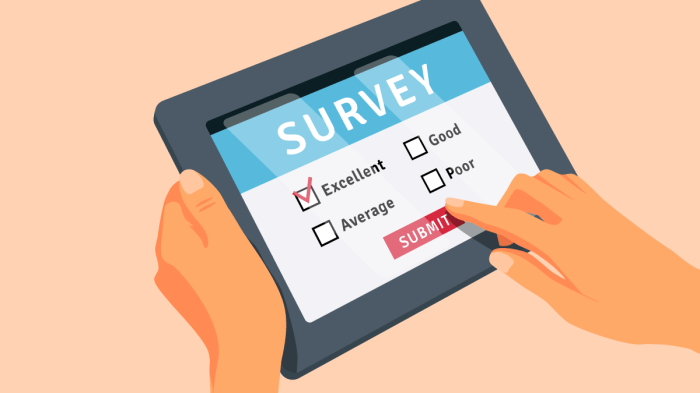Creating Online Surveys sets the stage for innovative data collection and analysis, offering insights into modern survey practices that go beyond traditional methods.
From designing engaging questionnaires to targeting the right audience and ethically handling data, this guide covers all aspects of online survey creation.
Introduction to Online Surveys

Online surveys are a popular method used to collect data and feedback from a target audience over the internet. These surveys are designed to gather information, opinions, and insights from participants in a quick and efficient manner.Some benefits of using online surveys include:
Cost-effective
Online surveys are often more affordable than traditional methods, such as phone or in-person interviews.
Wide reach
Surveys can be distributed to a large audience regardless of geographical location, allowing for a diverse pool of responses.
Real-time results
Data collected through online surveys can be analyzed instantly, providing immediate insights for decision-making.When comparing online surveys to traditional methods of data collection, online surveys offer several advantages. They are faster to conduct, more convenient for participants, and can be easily customized to target specific demographics or interests. Additionally, online surveys can reach a larger audience in a shorter amount of time, making them a popular choice for businesses, researchers, and organizations looking to gather feedback efficiently.
Designing Online Surveys: Creating Online Surveys
Creating effective online surveys requires careful consideration of the questions, layout, and design to ensure valuable and actionable insights. Let’s explore some key tips and best practices for designing online surveys.
Effective Survey Questions
When crafting survey questions, it’s essential to keep them clear, concise, and relevant to your research goals. Here are some tips for creating effective survey questions:
- Avoid leading or biased questions that may influence respondents’ answers.
- Use simple and straightforward language to ensure clarity.
- Avoid double-barreled questions that address more than one issue.
- Include a mix of question types, such as multiple-choice, open-ended, and rating scales, to gather diverse insights.
- Consider the order of questions to maintain a logical flow and engage respondents.
Importance of Survey Layout and Design
The layout and design of an online survey play a crucial role in engaging respondents and enhancing the overall survey experience. Here are some best practices for survey layout and design:
- Use a clean and visually appealing design with consistent formatting to improve readability.
- Organize questions into logical sections with clear headings to guide respondents through the survey.
- Incorporate white space to prevent survey fatigue and make the survey more visually appealing.
- Optimize the survey for mobile devices to ensure accessibility for all respondents.
- Include progress indicators to inform respondents about the survey’s length and their current position within the survey.
Structuring Online Surveys
Structuring online surveys effectively involves planning the survey flow, question sequence, and overall user experience. Here are some best practices for structuring online surveys:
- Start with a brief introduction to the survey’s purpose and instructions to set expectations for respondents.
- Group related questions together to maintain coherence and focus within the survey.
- Avoid overwhelming respondents with too many questions and consider using skip logic to tailor the survey based on respondent answers.
- Conclude the survey with a thank you message and an opportunity for respondents to provide additional feedback or comments.
Target Audience and Distribution
When it comes to online surveys, knowing your target audience is key. You want to make sure you’re asking the right people the right questions to get valuable insights. And once you’ve crafted the perfect survey, you need to distribute it effectively to get the responses you need. Let’s dive into how to define your target audience, different distribution methods, and tips for boosting response rates.
Defining Your Target Audience
- Start by outlining the demographics of your ideal survey respondents, such as age, gender, location, income level, and occupation.
- Consider the psychographics of your audience, including their interests, behaviors, and preferences.
- Think about the goals of your survey and who would be most relevant to provide the feedback you need.
Methods for Distributing Online Surveys
- Utilize email campaigns to reach out to your target audience directly.
- Share your survey on social media platforms to reach a wider audience.
- Embed your survey on your website or blog for visitors to easily access.
- Consider using paid advertising to promote your survey to a specific demographic.
Tips for Increasing Survey Response Rates, Creating Online Surveys
- Keep your survey short and to the point to avoid respondent fatigue.
- Offer an incentive for completing the survey, such as a discount code or entry into a giveaway.
- Send out reminders to those who haven’t completed the survey yet to encourage participation.
- Personalize your survey invitations to make them more engaging and relevant to the recipient.
Data Analysis and Reporting
When it comes to online surveys, analyzing the data you collect is crucial to gain meaningful insights and make informed decisions. In this section, we will explore techniques for effective data analysis and reporting in online surveys.
Techniques for Analyzing Survey Data Effectively
- Start by cleaning and organizing the data to ensure accuracy and reliability.
- Utilize statistical analysis to identify trends, patterns, and correlations within the data.
- Segment the data based on different variables to get a deeper understanding of specific groups or demographics.
- Use visualization tools such as charts, graphs, and tables to present the data in a clear and easy-to-understand format.
- Employ techniques like regression analysis or factor analysis for more advanced insights.
Tools and Software for Data Analysis in Online Surveys
- Popular tools like SPSS, Microsoft Excel, and Google Sheets are commonly used for data analysis in online surveys.
- Survey platforms like Qualtrics and SurveyMonkey offer built-in analytics features to help with data analysis and reporting.
- Data visualization tools such as Tableau or Power BI can be used to create interactive and informative reports.
- Consider using coding languages like R or Python for more advanced data analysis tasks.
Generating Insightful Reports from Survey Results
- Summarize the key findings and insights from the survey data in a concise and easy-to-read format.
- Include visual elements like charts, graphs, and infographics to make the report more engaging and informative.
- Provide actionable recommendations based on the survey results to drive decision-making and improvements.
- Consider sharing the report with stakeholders or team members to ensure transparency and collaboration.
Ethical Considerations in Online Surveys

When conducting online surveys, it is crucial to consider various ethical issues to ensure the protection and rights of participants. This includes obtaining informed consent, maintaining respondent anonymity, and safeguarding data privacy and confidentiality throughout the survey process.
Obtaining Informed Consent
When creating online surveys, it is essential to clearly Artikel the purpose of the survey, how the data will be used, and any potential risks or benefits for participants. Ensure that respondents provide explicit consent before participating in the survey by clicking an agreement box or providing a digital signature.
Ensuring Respondent Anonymity
To maintain respondent anonymity, avoid collecting any personally identifiable information unless absolutely necessary for the research. Use anonymous survey tools that do not track or store individual respondent data to protect their privacy and encourage honest responses.
Tips for Data Privacy and Confidentiality
- Use secure survey platforms with encryption to protect participant data from unauthorized access.
- Store survey data in a secure location and limit access to only authorized personnel involved in data analysis.
- Anonymize survey results before sharing or publishing to prevent the identification of individual respondents.
- Clearly communicate data handling practices and security measures to participants to build trust and transparency.
